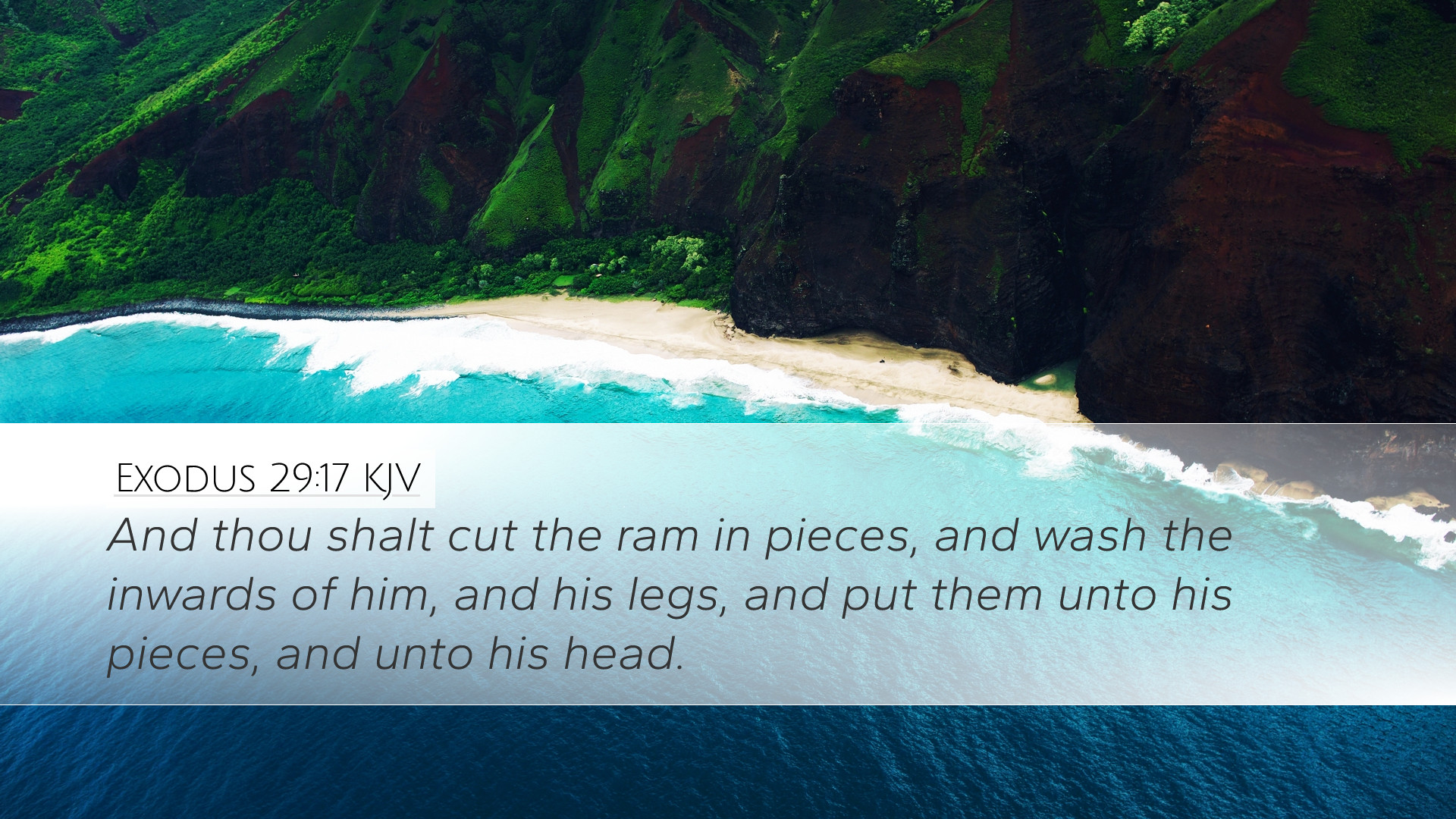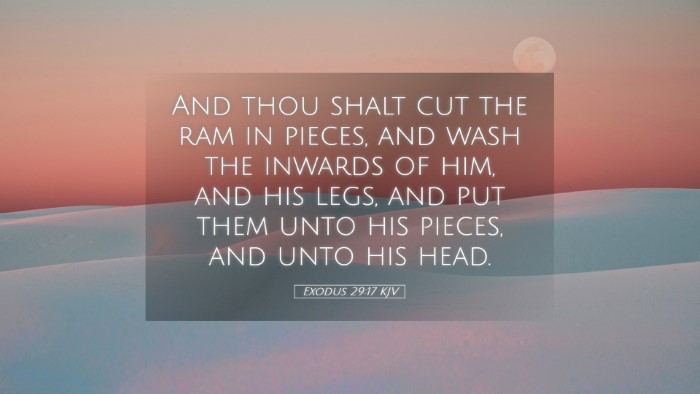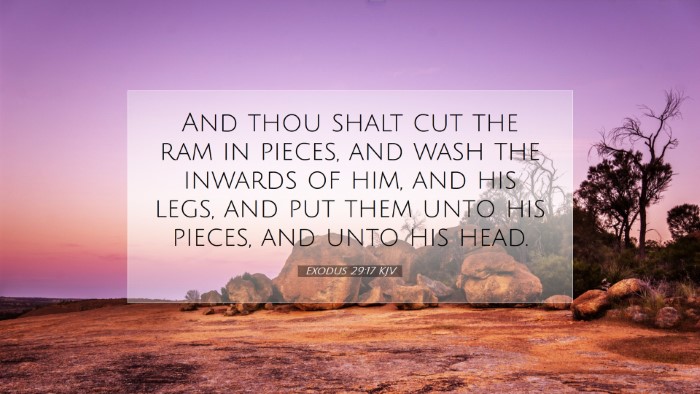Exodus 29:17 - Commentary and Insights
Verse Text: "And you shall cut the ram in pieces, and wash its entrails and its legs, and put them with its pieces and its head."
Introduction
The instructions regarding the sacrificial system in Exodus 29:17 offer deep theological insights and practical applications for understanding God's covenant with His people. This commentary synthesizes thoughts from well-regarded public domain scholars Matthew Henry, Albert Barnes, and Adam Clarke, providing a comprehensive exploration of the significance of this passage for pastors, students, theologians, and scholars.
The Context of Exodus 29
Exodus 29 details the consecration of the priests and the sacrificial offerings that are fundamental in establishing the covenant relationship between God and Israel. The rituals outlined are not merely ceremonial; they embody profound truths about holiness, atonement, and God's redemptive plan.
Holiness and Consecration
Henry emphasizes the importance of holiness in worship and priestly service. The act of cutting the ram into pieces symbolizes the necessity of separating sin and guilt from those who come before God. The ritual acts as a reminder that coming into God's presence requires purification and acknowledgment of the seriousness of sin. Furthermore, the meticulous procedures outlined ensure that worship is conducted with reverence and serious intent.
Symbolism of the Sacrifice
According to Barnes, the ram represents the complete submission and totality of the sacrifice required. This ram was not merely a token offering but a significant gift that establishes the seriousness of atonement in the context of a covenant relationship. The specific instructions to cut the ram into pieces and wash its entrails and legs reveal a process of thorough cleansing and acceptance before God. This purification process is essential, as it represents the internal and external purification necessary for approaching the divine.
The Role of Christ in the Sacrifice
Adam Clarke draws a parallel between the sacrificial system of the Old Testament and the ultimate sacrifice of Christ. He explains that the ram serves as a precursor to the Lamb of God who would take away the sins of the world. Understanding this connection allows us to appreciate the depth of what Jesus accomplished on the cross. The detail of washing the entrails points to the reality of Christ’s purity—a pure and unblemished lamb offered for the sin of mankind.
Analysis of Specific Elements in Exodus 29:17
-
Cutting the Ram in Pieces:
This action portrays the total surrender of the sacrifice, illustrating that nothing is retained for the worshiper’s personal benefit. Henry notes that it reflects the complete alienation from sin and total commitment to God.
-
Washing the Entrails and Legs:
Clarke elaborates that washing signifies the purification process, where God requires us to be cleansed wholly before Him. The entrails represent the inner life, indicating that one’s thoughts and motives must also be purified.
-
Putting them with its Pieces and its Head:
The teaching here emphasizes completeness in sacrifice. Barnes suggests that every part of the ram is essential, reflecting the holistic nature of atonement and the thoroughness required in the approach to God. This acts as a type of the unity of Christ's ministry, where all aspects of His being were involved in the atonement.
Theological Implications
This passage serves to reinforce key theological truths surrounding sin and sacrifice. In light of the entirety of Scripture, we see a consistent theme of blood being necessary for atonement (Hebrews 9:22). The details provided in Exodus 29:17 remind us of the gravity of sin and the cost of redemption, which must not be underestimated. Furthermore, the meticulous nature of the sacrificial system highlights God’s desire for His people to approach Him with sincerity and an understanding of His holiness.
Practical Applications
For contemporary believers, the insights gleaned from Exodus 29:17 can guide us spiritually in several ways:
-
The Importance of Holiness:
The call to holiness remains significant today. Believers are encouraged to examine themselves, ensuring that they come before God purified and ready to worship (1 Peter 1:16).
-
Understanding Atonement:
As we approach God, recognizing the solemnity of the sacrifice made on our behalf fosters an attitude of gratitude and reverence. Reflecting on Christ's total sacrifice enriches our worship and understanding of grace.
-
The Commitment to Follow:
Just as the ram was an offering symbolizing full submission, Christians are called to present their bodies as living sacrifices, holy and pleasing to God (Romans 12:1), emphasizing the call to live out our faith actively and sincerely.
Conclusion
Exodus 29:17, with its detailed prescriptions for sacrifice, serves as a vital reminder of God’s call for holiness, repentance, and sincere worship. The combined insights from Henry, Barnes, and Clarke reflect the richness of the text and offer profound truths relevant to the lives of believers today. In the context of the ultimate sacrifice of Christ, these verses invite us to deeply appreciate God's redemptive purpose and our response to His grace.


